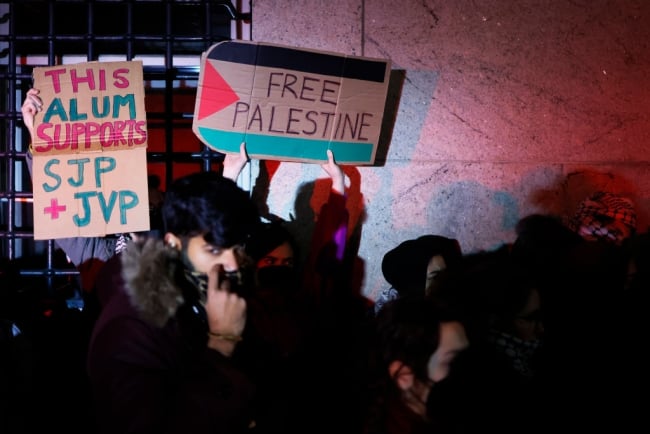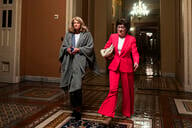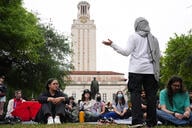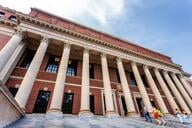You have /5 articles left.
Sign up for a free account or log in.

Protesters rallied against the suspension of Columbia University’s Students for Justice in Palestine and Jewish Voice for Peace chapters in November.
As protests raged on college campuses after the start of the Israel-Hamas war in October, Columbia University set out to codify clear-cut guidelines for on-campus demonstrations. But the announcement of the Student Group Event Policy and Procedure plan drew swift backlash for being overly restrictive; among other things, it required “special events”—including any gathering expected to draw “high attendance/capacity”—to be registered two weeks in advance.
Criticism of the policy mounted in November after Columbia suspended two pro-Palestinian student groups for violating it just two weeks after it was introduced.
Four months later, the university has released new guidelines, called the Interim University Policy for Safe Demonstrations. It was born in part out of concerns that the previous iteration had been established too “hastily,” said Dr. Jeanine D’Armiento, chair of Columbia’s University Senate executive committee and an associate professor of medicine in anesthesiology.
Unlike its predecessor, the new policy was created with input from the University Senate, which includes faculty, staff and students, she noted. Currently, both policies are in effect on campus.
The new one appears to walk back some of the more controversial aspects of the older one; for instance, it reduces the number of business days students must register an upcoming protest in advance from 10 to two.
But it also establishes spaces on campus where protests may take place—including central locations like the area near the Sundial, a prominent landmark on Columbia’s main Morningside campus. And students can petition for demonstration to take place outside the “demonstration zones.” Under the new policy, protests are also restricted to between noon and 6 p.m. on weekdays.
“This interim policy preserves the right of members of the Columbia community to be heard and streamlines the process to reduce the timeframe necessary for approval of a demonstration,” officials wrote when they announced the new policy on Feb. 19. “By clearly defining place and timing, the interim policy also accommodates members of the community who do not want to participate to work around these events.”
Columbia’s revamped rules represent the latest example of institutions attempting to balance students’ freedom of expression with concerns about safety amid ongoing protests related to Israel’s war in the Gaza Strip. Other institutions have similarly established new protest policies in an attempt to lessen tensions on campus; in January, American University announced it would disallow indoor protests. Around the same time, Harvard University sent out “clarifying” guidance about protests to students, which stated that, with limited exceptions, protests should not take place inside classrooms, libraries, dormitories, dining halls or offices. Barnard College, an affiliate of Columbia, recently released its own new protest policy, which drew fire for outlawing all dormitory door decorations.
Such changes have drawn criticism from free speech advocates, who anticipate that the new regulations could chill political speech on campus. But Columbia appears unique in its willingness to re-evaluate its approach and offer changes—including those that appear to make it at least somewhat easier for students to protest.
Columbia’s University Senate was most concerned about revising the sanctions described in the Student Group Event Policy and Procedure, which D’Armiento said contradicted existing student conduct rules because they could not be appealed and didn't utilize the University Judicial Board, the traditional avenue for reviewing student misconduct charges.
The new “interim” policy introduces a three-strike rule: a student’s first two violations will result in warnings, while the third will lead to a hearing before the University Judicial Board, which could result in punishments ranging from conditional disciplinary probation to expulsion. Those rulings can be appealed.
D’Armiento said offering two warnings was important to protect students who violate the regulations out of ignorance of their intricacies rather than purposeful disregard for safety and order. She added that she hopes the Judicial Board will take into account the nature of the prior violations when evaluating sanctions for students on their third strike.
“I would imagine if the other two [violations] were, ‘You stepped outside the box at 6:15 p.m.,’ your punishment is not going to be the same as someone who stood up and screamed in a lecture,” she said.
According to D’Armiento, the University Senate would have preferred there be no limitations on demonstrations at all, but it was willing to compromise with the university.
“We don’t believe in times of crisis you change your rules that had … stood the test of time,” she said. “We had protests all the time at Columbia; it’s a university that embraces protest.”
In response to an initial series of questions about the guidelines, a Columbia spokesperson relayed public information from the Feb. 19 announcement and did not respond to a subsequent inquiry.
Safety vs. Speech
The new policy has received mixed feedback. James Applegate, a professor of astronomy and a member of the University Senate’s executive committee, said he thought it illustrated one of the most effective political compromises he had witnessed at Columbia or elsewhere.
He lauded the substantial freedoms students are still afforded—including the ability to protest in some of the campus’s most visible spots—even as the changes help ease university leaders’ worries about congressional scrutiny and Title VI lawsuits.
“Nobody got everything they want, but I think everybody got what they needed,” he said. “And that’s a recipe for good politics.”
The policy is also explicitly viewpoint neutral; it includes a clause asserting, “The university may not deny registration or approval of an exception for any demonstration based on the viewpoint of the individual or group seeking to hold the demonstration.”
But some student protesters believe the new rules diminish their freedoms while doing little for their safety. They include Layla Saliba, a Palestinian American graduate student at the Columbia School of Social Work, who was among the students hit by a chemical spray during a protest on campus in January.
Saliba does not believe any element of the new policy would have prevented that attack, for which she said she is still receiving medical care.
“These policies, I feel like they are more to appease donors than to protect student safety,” she said.
She questioned the university’s decision to try to restrict student protests in the first place.
“I realize that this is a tricky situation for colleges, because there are a lot of interests, there are a lot of demands that are being made on them and they are under a lot of pressure,“ she said. “But I think when it comes to these demonstrations and these protests, free speech really needs to be accounted for and needs to be a priority. My family has been bombed. To hear people chant, ‘No ceasefire’—that makes me uncomfortable. That makes me feel unsafe. But I realize they have free speech.”
Experts echoed Saliba’s wariness about restricting free speech—even at a private university like Columbia, which is not legally obligated to uphold First Amendment rights. Kristen Shahverdian, program manager of free expression and education at PEN America, said that even requiring students to register a protest two days in advance is too much, as it restricts their ability to respond in real time to events in the world or at their institution. And while she appreciates that the designated demonstration zones at Columbia are high-traffic spots, she finds the existence of demonstration zones in any capacity problematic.
“Any speech that falls outside these [zones] … what happens there?” she asked. “It sends a message generally to students that free speech is only allowed or contained to these areas of campus.”
According to Applegate, the policy is slated for re-evaluation at the end of the semester. D’Armiento said she believes it is unlikely the university will ever return to the less restricted free speech culture Columbia students enjoyed prior to Oct. 7.
When they re-examine the policy, she said, she wants to make sure they look closely at whether student protesters—especially those who violated the guidelines—were treated fairly.
“We have to ask ourselves what is our purpose with the policy,” she said. “And what is our purpose as an educational institution.”




